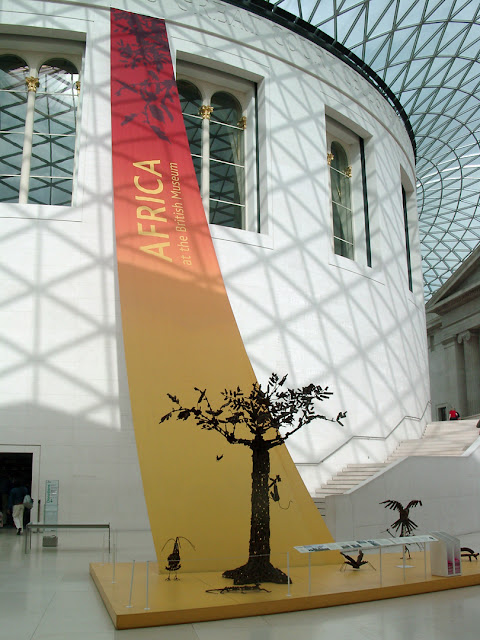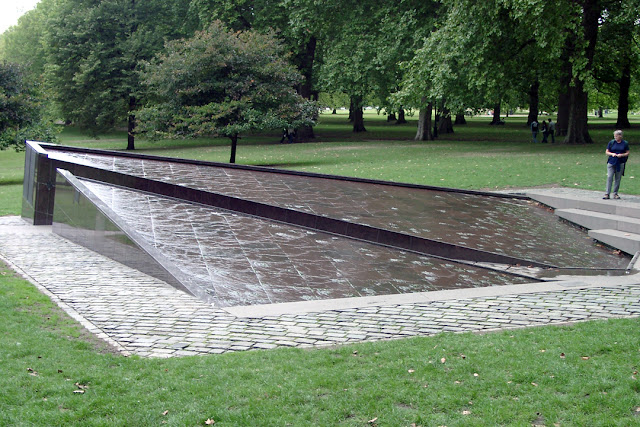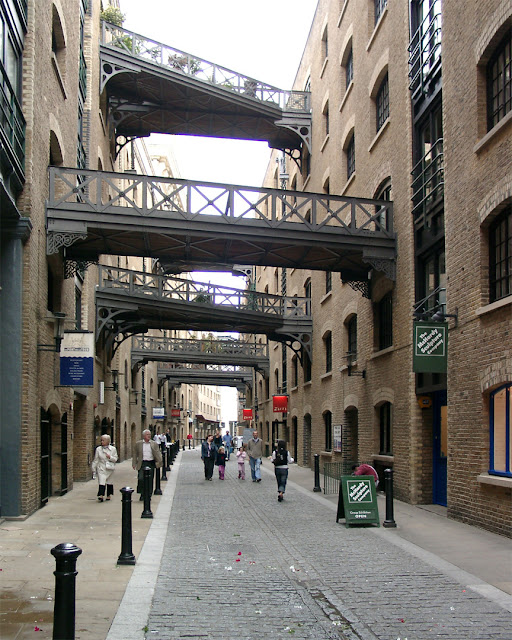Thursday, November 30, 2006
Wednesday, November 29, 2006
Broadcasting House
Broadcasting House
Portland Place, Marylebone
London, September 2005
“Broadcasting House is the headquarters of the BBC, in Portland Place and Langham Place, London. The first radio broadcast from the building was made on 15 March 1932, and the building was officially opened two months later, on 15 May. The main building is in Art Deco style, with a facing of Portland stone over a steel frame. It is a Grade II* listed building and includes the BBC Radio Theatre, where music and speech programmes are recorded in front of a studio audience.” (Broadcasting House, Wikipedia)
Tuesday, November 28, 2006
Monday, November 27, 2006
Royal Artillery Memorial
Royal Artillery Memorial, 1825
Hyde Park Corner
London, September 2005
“The Royal Artillery Memorial is a First World War memorial located on Hyde Park Corner in London, England. Designed by Charles Sargeant Jagger, with architectural work by Lionel Pearson, and unveiled in 1925, the memorial commemorates the 49,076 soldiers from the Royal Artillery killed in the First World War. The static nature of the conflict, particularly on the Western Front, meant that artillery played a major role in the war, though physical reminders of the fighting were often avoided in the years after the war. The Royal Artillery War Commemoration Fund (RAWCF) was formed in 1918 to preside over the regiment's commemorations, aware of some dissatisfaction with memorials to previous wars. The RAWCF approached several eminent architects but its insistence on a visual representation of artillery meant that none was able to produce a satisfactory design. Thus they approached Jagger, himself an ex-soldier who had been wounded in the war. Jagger produced a design which was accepted in 1922, though he modified it several times before construction.” (Royal Artillery Memorial, Wikipedia)
Sunday, November 26, 2006
Ionic Screen
Ionic Screen by Decimus Burton
Hyde Park Corner
London, September 2005
“The renovation of Hyde Park, Green Park, and St James's Park, began, in 1825, with the demarcation of new drives and pathways, subsequent to which Burton designed new lodges and gates, viz. Cumberland Gate, Stanhope Gate, Grosvenor Gate, the Hyde Park Gate/Screen at Hyde Park Corner, and, later, the Prince of Wales's Gate, Knightsbridge, in the classical style. There were no authoritative precedents for such buildings, which required windows and chimney stacks, in the classical style, and, in the words of Guy Williams, 'Burton's reticent treatment of the supernumerary features' and of the cast iron gates and railings, was 'greatly admired'. At Hyde Park Corner, the King required that 'some great ceremonial outwork that would be worthy of the new palace that lay to its rear', and accepted Burton's consequent proposal for a sequence comprising a gateway and a classical screen, and a triumphal arch, which would enable those approaching Buckingham Palace from the north to ride or drive first through the screen and then through the arch, before turning left to descend Constitution Hill and enter the forecourt of Buckingham Palace through Nash's Marble Arch. The screen became the Roman revival Hyde Park Gate/Screen at Hyde Park Corner, which delighted the King and his Committee, and which architectural historian Guy Williams describes as 'one of the most pleasing architectural works that have survived from the neo-classical age'.” (Hyde Park Corner, Wikipedia)
Saturday, November 25, 2006
Apsley House
Apsley House
Piccadilly
Hyde Park Corner
London, September 2005
“Apsley House is the London townhouse of the Dukes of Wellington. It stands alone at Hyde Park Corner, on the south-east corner of Hyde Park, facing south towards the busy traffic roundabout in the centre of which stands the Wellington Arch. It is a Grade I listed building. It is sometimes referred to as the Wellington Museum, its official designation under a 1947 Act of Parliament. The house is now run by English Heritage and is open to the public as a museum and art gallery, exhibiting the Wellington Collection, a large collection of paintings, other artworks and memorabilia of the career of the 1st Duke. The 9th Duke of Wellington retains the use of part of the buildings. It is perhaps the only preserved example of an English aristocratic townhouse from its period. The practice has been to maintain the rooms as far as possible in the original style and decor.” (Apsley House, Wikipedia)
Friday, November 24, 2006
Wellington Arch
Wellington Arch by Decimus Burton
Hyde Park Corner
London, September 2005
“Wellington Arch, also known as Constitution Arch or (originally) as the Green Park Arch, is a Grade I-listed triumphal arch by Decimus Burton that forms a centrepiece of Hyde Park Corner in central London, between corners of Hyde Park and Green Park; it stands on a large traffic island with crossings for pedestrian access. From its construction in 1826 until 1830 the arch stood in a different location nearby; it was moved to its current site in 1882–1883. It originally supported a colossal equestrian statue of the 1st Duke of Wellington by the sculptor Matthew Cotes Wyatt, as a result of which it has acquired the name "the Wellington Arch" in the vernacular. A bronze quadriga (an ancient four-horse chariot) by Adrian Jones has surmounted it since 1912.” (Wellington Arch, Wikipedia)
Thursday, November 23, 2006
Canada Memorial
Canada Memorial by Pierre Granche, 1992
Green Park
City of Westminster
London, September 2005
“The Canada Memorial in Green Park, London, United Kingdom, commemorates members of the Canadian Forces killed during the First and Second World Wars. It was designed by the Canadian sculptor Pierre Granche, erected in 1992 and unveiled by Queen Elizabeth II in 1994. The memorial was the result of lobbying and fund raising, much of it in Canada, by the former Canadian media tycoon Conrad Black.” (Canada Memorial, Wikipedia)
Wednesday, November 22, 2006
Buckingham Palace
Buckingham Palace
City of Westminster
London, September 2005
“Buckingham Palace is the London residence and administrative headquarters of the monarch of the United Kingdom. Located in the City of Westminster, the palace is often at the centre of state occasions and royal hospitality. It has been a focal point for the British people at times of national rejoicing and mourning. Originally known as Buckingham House, the building at the core of today's palace was a large townhouse built for the Duke of Buckingham in 1703 on a site that had been in private ownership for at least 150 years. It was acquired by King George III in 1761 as a private residence for Queen Charlotte and became known as The Queen's House. During the 19th century it was enlarged, principally by architects John Nash and Edward Blore, who constructed three wings around a central courtyard. Buckingham Palace became the London residence of the British monarch on the accession of Queen Victoria in 1837.” (Buckingham Palace, Wikipedia)
Tuesday, November 21, 2006
Buckingham Palace Ticket Office
Buckingham Palace Ticket Office by Hopkins Architects, 1995
Green Park
City of Westminster
London, September 2005
Monday, November 20, 2006
The International Shakespeare Globe Centre
The International Shakespeare Globe Centre
New Globe Walk
Bankside, Southwark
London, September 2005
“In 1970, American actor and director Sam Wanamaker founded the Shakespeare Globe Trust and the International Shakespeare Globe Centre, with the objective of building a faithful recreation of Shakespeare's Globe close to its original location at Bankside, Southwark. This inspired the founding of a number of Shakespeare's Globe Centres around the world, an activity in which Wanamaker also participated.” (Shakespeare's Globe, Wikipedia)
Sunday, November 19, 2006
Vinopolis
Vinopolis
Bank End, Southwark
London, September 2005
“Vinopolis was a commercial visitor attraction in Southwark, London, England, operated by Wineworld, London that presented the subject of wine and oenology through exhibits and wine tastings. Vinopolis closed permanently at the end of 2015. Vinopolis was located at Bankside, to the east of Southwark Bridge and close to London Bridge on the southern side of the River Thames. There was an attached restaurant, Cantina Vinopolis, and wine was available for sale at the attached Laithwaites Wine Store. Vinopolis spanned 2.5 acres (10,000 m2) and was devoted to the world of wine, including its history, development and taste. Within the complex was also a specialist whisky retailer The Whisky Exchange which offered a range of several hundred whiskies and other spirits for sale. The Whisky Exchange also organised various whisky tasting events throughout the year at Vinopolis.” (Vinopolis, Wikipedia)
Saturday, November 18, 2006
The Holy Family
The Holy Family by Kenneth Hughes
Southern side of the churchyard
Southwark Cathedral
London Bridge, Southwark
London, September 2005
Friday, November 17, 2006
Thursday, November 16, 2006
Richard Benefeld
Monument of Richard Benefeld, mid 17th-century
Southwark Cathedral
London Bridge, Southwark
London, September 2005
Wednesday, November 15, 2006
Tuesday, November 14, 2006
Monday, November 13, 2006
Sunday, November 12, 2006
Northern & Shell Building
Northern & Shell Building, 1985
Lower Thames Street, Billingsgate
City of London
London, September 2005
Saturday, November 11, 2006
Thames sailing barge
Thames sailing barge
London Bridge City Pier
Southwark
London, September 2005
“A Thames sailing barge is a type of commercial sailing boat once common on the River Thames in London. The flat-bottomed barges with a shallow draught and leeboards, were perfectly adapted to the Thames Estuary, with its shallow waters and narrow tributary rivers. The larger barges were seaworthy vessels, and were the largest sailing vessel to be handled by just two men. The average size was about 120 tons and they carried 4,200 square feet (390 m2) of canvas sail in six working sails. The mainsail was loose-footed and set up with a sprit, and was brailed to the mast when not needed. It is sheeted to a horse, as is the foresail; they require no attention when tacking. The foresail is often held back by the mate to help the vessel come about more swiftly.” (Thames sailing barge, Wikipedia)
Friday, November 10, 2006
Thursday, November 9, 2006
Wednesday, November 8, 2006
Tuesday, November 7, 2006
Monday, November 6, 2006
Sunday, November 5, 2006
Saturday, November 4, 2006
Exotic Cargo
Exotic Cargo Peter Randall-Page, 1995
St Saviour's Dock
Bermondsey, Southwark
London, September 2005
Friday, November 3, 2006
Head of Invention
Head of Invention by Eduardo Paolozzi
Design Museum
Shad Thames
Bermondsey, Southwark
London, September 2005
Thursday, November 2, 2006
Shad Thames
Shad Thames
Bermondsey, Southwark
London, September 2005
“Shad Thames is a historic riverside street next to Tower Bridge in Bermondsey, London, England, and is also an informal name for the surrounding area. In the 19th century, the area included the largest warehouse complex in London. The street Shad Thames has Tower Bridge at its west end, and runs along the south side of the River Thames, set back behind a row of converted warehouses; it then takes a 90-degree turn south along St Saviour's Dock. The street is partly cobbled. The nearest stations are Tower Hill, Tower Gateway (both requiring one to cross the river to access them), Bermondsey and London Bridge.” (Shad Thames, Wikipedia)
Wednesday, November 1, 2006
Subscribe to:
Posts (Atom)






























